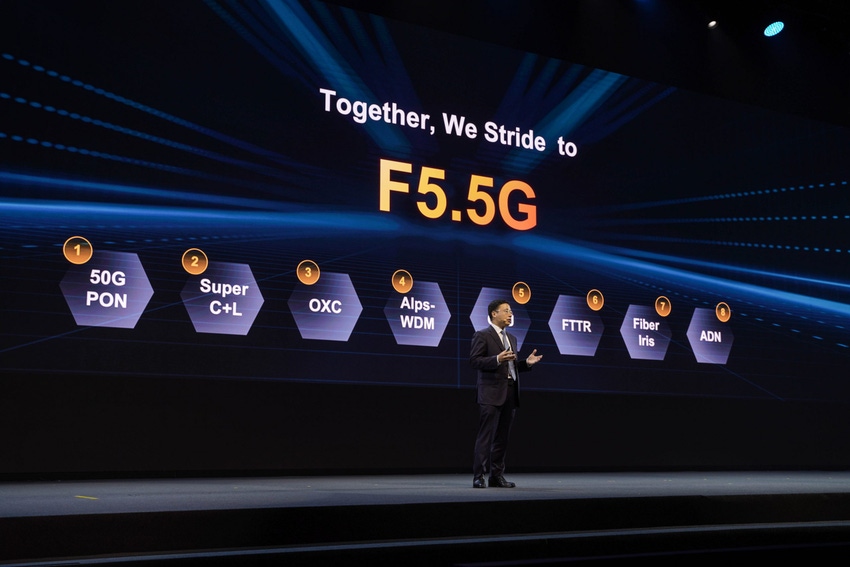Huawei: F5.5G innovation can turbo-boost fiber
November 30, 2022

Sponsored Content
By Ken Wieland, Light Reading contributing editor
If carriers are to generate new revenue streams, they’ll need technology innovation. In fixed-line networks that means pushing the boundaries of fiber performance, all the way from the data center to the optical network terminal/optical network unit (ONT/ONU).
The fixed network industry has already laid the foundations for fiber innovation, setting out guidance for unified standards to avoid fragmentation
In 2020, the European Telecommunications Standards Institute (ETSI) released the Fifth Generation Fixed Network (F5G) standard. It focused on defining three key features: enhanced fixed broadband (eFBB), full-fiber connections (FFC) and guaranteed reliable experience (GRE).
F5G under pressure
Demand for better fixed line performance never stops, however, and will put a strain on F5G networks.
According to some estimates computing networks used for industrial digital transformation, by 2025-30, will require about five times more bandwidth than they do today, support 10 times more connections, and offer microsecond-level ultra-low latency.
Delivering XR, holographic imaging, and naked-eye 3D services – where three dimensional displays don’t require any special glasses to view 3D images – also need the extra bandwidth and low latencies that fiber innovation can bring. These types of services are expected to become more commonplace in homes and enterprises of the future.
In some ways the future is already here. There are already over one million installations of fiber-to-the-room (FTTR), a next-generation fiber solution pioneered by Huawei using centralized Wi-Fi access network (C-WAN) architecture. Huawei expects that number to reach 2 million worldwide by the end of this year.
It’s not only Huawei that thinks the FTTR market is poised for stellar growth. Because of increasing demands on the home network from new and innovative applications, research firm Omdia forecasts the FTTR share of global fiber-to-the-home (FTTH) subscriptions will reach 17% by 2030.
Now’s the time for F5.5G
F5G networks clearly need to evolve, then, if they are to support more stringent performance demands of future services.
It’s why Huawei, working in collaboration with ETSI, China Academy of Information and Communications Technology (CAICT), China Telecom, China Mobile, China Unicom, Globe Telecom and MTN Group, proposed the F5G industry evolution initiative
The F5.5G proposal was unveiled in April this year at a summit hosted by Informa Tech. It extends the scope of F5G from eFBB, FFC and GRE into three new dimensions: green agile optical networks (GAO), real-time resilient links (RRL) and optical sensing and visualization (OSV).
The enhanced F5G framework architecture not only sets out much higher performance goals than F5G but is also laser-focused on opex containment, helped by upgrades of Autonomous Driving Networks (ADNs) from Layer 3 to Layer 4. There’s also greater reliance on green and low-carbon technologies. F5.5G aims to boost network energy efficiency tenfold thanks to low energy consumption of optical equipment.
Another F5.5G performance requirement is to reduce deterministic network latency to microseconds, allowing industrial robot control. Boosting network reliability from ‘four nines’ (99.99%) to six nines is also on the F5.5G roadmap.
Huawei, working alongside operators and industry partners, is committed to F5.5G innovation.
“Innovation will never stop,” said Richard Jin, President of Huawei’s Optical Business Product Line. “Huawei will continue to innovate in F5.5G, focusing on 10Gbps everywhere, all-optical switching, industrial applications and the integration of communication and sensing.”
Huawei F5.5G innovation on display
Jin was speaking at the recent UBBF 2022 event in Bangkok, Thailand. In a presentation entitled ‘Unleash Fiber Potential, Stride to F5.5G,’ Jin enthused about fiber as a “future-orientated” technology and a “strategic resource” for operators,
He paraded a raft of Huawei F5.5G innovations. These included a 50G PON architecture, covering distances of 40km by adopting innovative taper amplifiers and high sensitivity receivers. There’s also an upgrade path from existing 10G PONs through ‘combo cards’ using advanced silicon photonic integration.
“Through these innovations, operators can reuse the existing ODN [optical distribution network] and smoothly upgrade the network to 50G-PON,” said Jin.
Jin also highlighted work on developing higher density optical cross connection (OXC) equipment, which Huawei views as a “key enabler” for GAO. “We’ve adopted a 3D lattice algorithm to improve the fiber density of the optical backplane by 35%,” he noted. “One sheet of A4 paper can print 1000 fibers. Compared to conventional ROADM, OXC could save 90% space and reduce power consumption by 60%.”
Huawei, added Jin, has also made headway in L-Band spectrum amplification. Using high concentration doping techniques, Huawei says it has increased ‘super C+L spectrum’ by 50%, to 12THz.
“Combining 400G/800G with super C+L, we could reach 100Tbps capacity in a single fiber,” asserted Jin. Performance levels of this sort, he said, will help usher in the ‘10Gbps-everywhere’ era.
Other Huawei F5.5G innovation on show at UBBF 2022 included Huawei OptiX Alps-WDM, a metro solution aimed at lower total cost of ownership, and Fiber Iris, which is designed to help management of ODNs.
Compared with a metro solution, Jin said, Huawei OptiX Alps-WDM, can provide 10x higher bandwidth, reduce footprint by tenfold, support a 10-year evolution lifecycle, and save 20% of opex annually.
AI-empowered Fiber Iris, when applied to ODN networks, purportedly ensures 100% resource accuracy, so improving time-to-market and protecting investment without any ports wasted.
“We need to work together [and] welcome operators and industry partners to join F5.5G innovation to fully improve capabilities and seize opportunities in the digital wave,” concluded Jin at the end of his presentation. “Let’s work together to stride to F5.5G.”
Read more about:
Vendor SpotlightsYou May Also Like









_1.jpg?width=300&auto=webp&quality=80&disable=upscale)


.png?width=800&auto=webp&quality=80&disable=upscale)